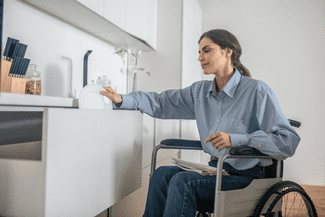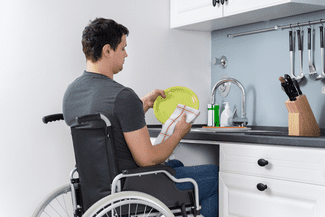6 Low-Cost Updates to Make Your Kitchen Wheelchair Accessible
Making your kitchen wheelchair accessible doesn’t have to cost thousands of dollars. Here are a few budget-friendly improvements you can do right away.

Those living with a disability are also paying more rent—the Apartment List analysis found that more than half of renters with a physical disability are cost-burdened (paying more than the recommended 30% of their income on rent), compared to those without a disability.
If you or someone you’re living with has a physical disability and uses a wheelchair, there are budget-friendly ways to make common spaces such as the kitchen and bathroom more accessible. Although projects such as lowering your kitchen cabinets can cost a lot of money, there are more affordable upgrades you can easily pull off.
While there are many options to make your space more wheelchair accessible, “any renovations should be specific for the actual needs of the person who will be using the kitchen,” says Elizabeth Kennedy, a certified Aging In Place specialist and founder of Age Fearless Academy, which helps older adults and their kids create optimal home environments for those with challenges in mobility.
Here are some low-cost kitchen upgrades to make sure your kitchen is set up properly for easier mobility and function.
1. Add a ramp into the kitchen.
Add a ramp into the kitchen to make it easier for someone in a wheelchair to access. The project doesn’t have to be overly complicated or costly.
“The cheapest way to make a kitchen wheelchair accessible is by adding a front lip on the threshold and installing ramps leading up to it (these can be done for less than $1,000),” says Kate Diaz, interior designer and founder of home improvement and decor site, SwankyDen.
James Watson, founder of Omaha Homes for Cash, a home buying company that fixes and flips homes, says the project can be done for even less—about $50 with some plywood and a transition piece ($40, Lowe’s).
“If there is an attached garage off of the kitchen, with one to three stairs, a single sheet of 1/2- to 3/4-inch plywood should do the trick,” explains Watson. “Finish it off with a transition piece where the plywood meets the door/floors, and you are all set,” he adds.
2. Add a small drop-leaf table for easier access to a countertop.
If you have a large kitchen table, Kennedy suggests replacing it with a smaller drop-leaf table ($220, Wayfair) to create more space for the person in the wheelchair to move in the kitchen. Depending on the type of table you get, Kennedy estimates the price to be between $100 to $300. The table can also be used as a lower countertop for appliances, such as a microwave or toaster, or prepping meals.
For easier prep, Diaz recommends adding an under-cabinet cutting board, which should cost about $30 depending on the size of your kitchen.
If you have a bigger budget, you can install, rebuild, or move a kitchen island to make more space for a wheelchair to move around and to make countertops easier to access. Kennedy says this can cost between $500 to $2,000.
3. Remove the cabinets under a sink.

Depending on factors like the style of cabinets and their price, the project could cost $600 to $1,500. “[The project] may require moving pipes to the rear of the space so the legs of the wheelchair user can fit,” says Kennedy.
4. Lower power outlets.
Kitchens tend to have lots of appliances, so consider lowering the power outlets to make the kitchen more wheelchair-accessible.
“Lower power outlets would make the plugging and unplugging of appliances much easier,” says Joel Phillips, home remodeler and founder of Home Guide Corner. “The ideal placement would be just at your height when you’re in a wheelchair,” says Phillips. He says the project can be done for less than $100, making it a pretty affordable option.
For a more economical choice, Kennedy suggests installing smart outlets ($20, The Home Depot) that allow you to control features with a remote or from your phone.
5. Install pull-down inserts in cabinets.
Add pull-out shelves and lazy Susans in cabinets to make items easier to find and reach. “Adding features such as rotary-type storage and pull-out shelves can be helpful,” says Benjamin Stenson, CEO of Kentucky-based home remodeling company Norsemen.
Kennedy estimates the project to cost around $100 to $300 per cabinet, but it could cost less depending on the type of cabinets you go for.
6. Add a touchless faucet and soap dispenser.
Another budget-friendly kitchen addition is a touchless faucet and automatic soap dispenser. Kennedy says these are great “for ease of use because it’s hard to reach the back of the sink from a seated position.”
You can find motion sensor faucets ranging from $150 to $400, like this top-rated touchless faucet from The Home Depot that’s on sale for $139 (it was $250). You can usually find automatic soap dispensers for less than $20.
Source: Better Homes & Gardens















 Accessibility
Accessibility